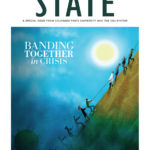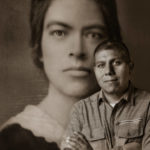Female students learned in chemistry labs during the university’s early years. Photo: CSU Libraries, Archives & Special Collections
Five years ago, controversy erupted when Nobel laureate Tim Hunt, a British biochemist, quipped about the “trouble with girls” in science – conference remarks meant to be funny and ironic that instead hit as shockingly sexist.
The comments, from one of the world’s most decorated scientists, exposed long-standing gender disparities at the research bench, even as women’s professional contributions have critically advanced knowledge and societal well-being.
Retorts flooded Twitter. Female scientists posted workaday selfies, wearing head-to-toe biosafety gear, toiling at archeological digs, and collecting wildlife feces. They used the hashtag #DistractinglySexy in reference to Hunt’s remarks.
Since I’ve noted one Nobel Prize winner, let’s consider another: Marie Curie, the physicist who won two Nobel Prizes for pioneering research into radioactivity, in 1903 and 1911, becoming the first woman to earn the highest international honor for scientific and cultural revelations – and the first person to earn two. Thank her for X-rays and for demonstrating, more than a century ago, what women in science can achieve.
During the pandemic, female researchers at Colorado State University are taking a notable lead in the search for insights and innovations to combat COVID-19. They offer a striking counterpoint to issues on display during the Hunt controversy, which continue to dog science. The visibility and value of this work is surely a lasting – and positive – outcome of the historic crisis.
For instance, Candace Mathiason, a prion scientist, leads CSU’s Infectious Disease Research and Response Network, designated as a Program of Research and Scholarly Excellence. She also co-founded a campus group to encourage women as scientific leaders. More notable than her gender is Mathiason’s role as a champion of interdisciplinary collaboration.
It’s working. By Aug. 1, network teams comprising men and women had submitted 101 of the university’s 152 proposals to agencies funding COVID-19 investigations; that’s 66 percent of CSU’s coronavirus research concepts, amounting to more than $45 million in investigative proposals. At the start of August, those proposals had secured more than $6.3 million in research funding for the university; this tally will surely rise.
Women lead two of CSU’s four COVID-19 vaccine projects, both built on centuries-old solutions to ruinous infectious disease and both certain to advance knowledge, regardless of which international laboratory gets to the vaccine finish line first. Amy MacNeill is drawing on the method used to eradicate smallpox, while Mary Jackson is redirecting the best-known shield against tuberculosis.

Female researchers landed both of Colorado State’s grants from the Boettcher Foundation, offered specifically to fight COVID-19: Rushika Perera leads an effort to test hundreds of existing drugs, compounds, and chemicals for efficacy against the novel coronavirus; and Sue VandeWoude, a newly named University Distinguished Professor, is developing a surveillance project to assess disease risk among vulnerable populations and to guide workforce redeployment during economic recovery.
That’s just a beginning. Rebekah Kading is studying the movement of viruses from bats to humans. Nicole Ehrhart leads a high-profile surveillance project, in partnership with the Colorado Department of Public Health and Environment, to understand the spread of disease among nursing home residents and employees – an undertaking that will test 45,000 people in an effort to protect older, high-risk Coloradans who live in long-term care facilities. The research project, bringing more than $4 million to CSU, aims to illuminate the spread of COVID-19 from those who are infected but asymptomatic, a knotty problem in this pandemic. Tied to that project is a new role for our Veterinary Diagnostic Laboratories, directed by Kristy Pabilonia. The laboratories are analyzing samples from the screening project after Pabilonia and team hustled to secure regulatory approval. The work expands the role of a key campus asset in infectious disease surveillance and diagnostics and illustrates the importance of connections between veterinary medicine and human medicine.
These are just a few of the women in CSU’s research community who are digging deep for solutions during a crisis that is staggering in its reach and impact. The university’s female investigators are working in fields including aerosol science, agricultural economics, and wastewater epidemiology to tackle this emergency. Their work is changing the culture and face of science for the world’s benefit.
So let’s give women in science their due. Not because of their gender. Because of their expertise.
Coleman Cornelius, a CSU alumna, is a longtime journalist and executive editor of STATE and Colorado State Magazine. She often writes about science and research.





